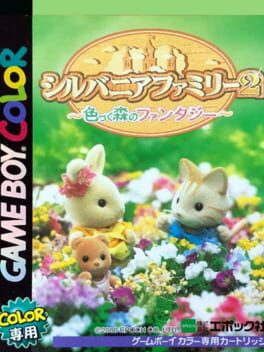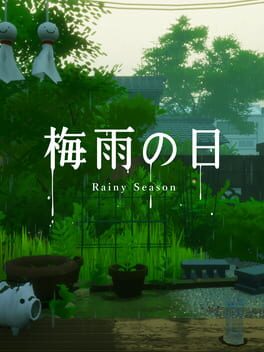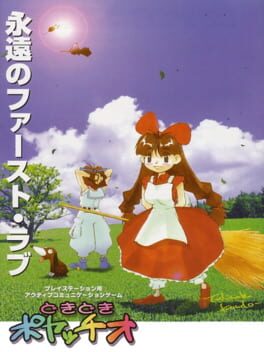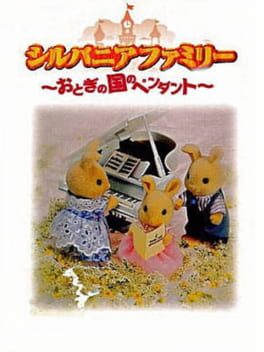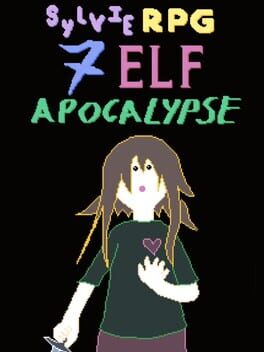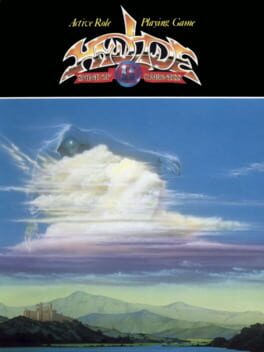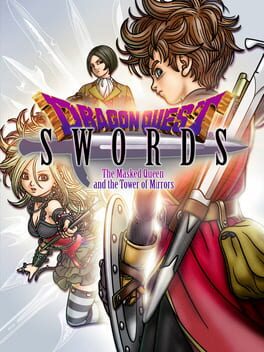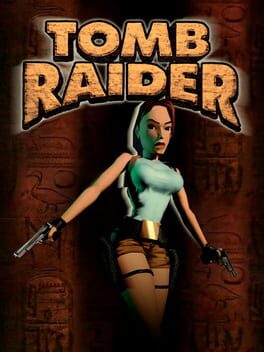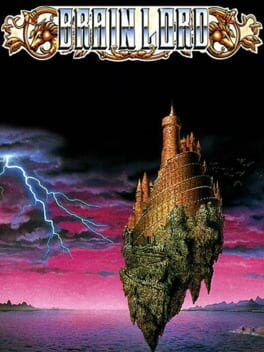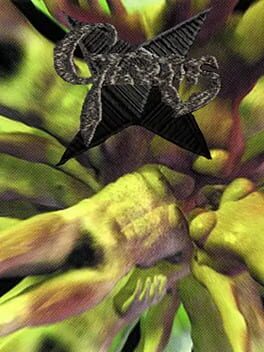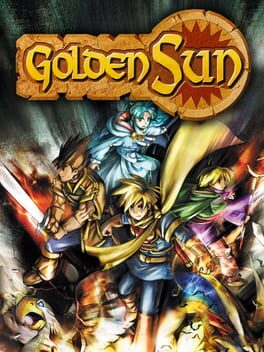MelosHanTani
BACKER
review of the first: https://www.backloggd.com/u/MelosHanTani/review/1572193/
What do game sequels do? That's always a fun question to explore. There's a lot of directions they can take, so... what did this series of kids' games based on a popular animal dollhouse toy series do?
---
Sylvanian Families 2 (SF2) takes a standard approach - more of everything. Bigger world, seasons, slower level progression.
They added school events - in the Spring it's stargazing, and in the Summer, it's camping - complete with a 'folk dance' minigame where you must pick a boy to dance with (for you are a girl). (Of course, the boys set up the tents, the girls make the curry) .
Some characters are still weirdly insistent you always return home by 6 PM - probably because it's a fairly strict rule where you lose progress for hitting 6 PM without returning home.
The game is tutorialized better - shop NPCs now cite a fictional 'guidebook' that suggests one ought to 'do minigames at the school to level up before trying to walk further'. Instead of the furniture store being... in your dreams... it's at a furniture store.
---
I think I prefer SF1 over SF2 because it's shorter - rather than a big experience with More Everything! SF1 feels more like, well, a toy, that kinda sits off in your closet somewhere, to be enjoyed for a few minutes every now and then.
Not that SF2 is that much worse than SF1, but mainly I want to move on to the 3rd and 2-3 hours each with these games feels like enough to get the gist.
--
On another note, this game makes me think: there's something a little misguided in the idea of marketing a game at kids - and then making it about things the kids are already doing (going to school, doing events) - isn't it? A kid already has to be home at 6 PM. What's the point of making a game where the kid has to do the same thing?
Did these games sell well, or was it just an attempt at branching out by the parent company Epoch? Was the main playerbase kids, or actually adults who collect the toys? (Maybe.) Was the gameplay simple 'for kids' or for adults who may not play games often? Life has no answers to such questions...
But if we take this to be a 'kids' game', it's worth thinking about how complex 'kids games' have gotten in the past 15 years with Minecraft/Roblox - or arguably, how complex they've always been - Neopets and HTML scripting, etc.
I don't know what the 'meta' is for making games for kids nowadays (if that's even viable at all,) but whenever I look at something aimed 'at kids' that's also seemingly a little too straightforward it makes me wonder if it's infantilizing to simplify something past a certain point, when kids can make up their own rules playing stuff like Minecraft. If I think back to being a kid, being 4 - maybe 3 - years old was old enough to Judge And Remember Adults. I feel like anyone trying to engage with kids should remember this. Kids' Media can probably do more... or, at the least, scare the kids with glitches. https://twitter.com/han_tani2/status/1786933397849591857/photo/1
What do game sequels do? That's always a fun question to explore. There's a lot of directions they can take, so... what did this series of kids' games based on a popular animal dollhouse toy series do?
---
Sylvanian Families 2 (SF2) takes a standard approach - more of everything. Bigger world, seasons, slower level progression.
They added school events - in the Spring it's stargazing, and in the Summer, it's camping - complete with a 'folk dance' minigame where you must pick a boy to dance with (for you are a girl). (Of course, the boys set up the tents, the girls make the curry) .
Some characters are still weirdly insistent you always return home by 6 PM - probably because it's a fairly strict rule where you lose progress for hitting 6 PM without returning home.
The game is tutorialized better - shop NPCs now cite a fictional 'guidebook' that suggests one ought to 'do minigames at the school to level up before trying to walk further'. Instead of the furniture store being... in your dreams... it's at a furniture store.
---
I think I prefer SF1 over SF2 because it's shorter - rather than a big experience with More Everything! SF1 feels more like, well, a toy, that kinda sits off in your closet somewhere, to be enjoyed for a few minutes every now and then.
Not that SF2 is that much worse than SF1, but mainly I want to move on to the 3rd and 2-3 hours each with these games feels like enough to get the gist.
--
On another note, this game makes me think: there's something a little misguided in the idea of marketing a game at kids - and then making it about things the kids are already doing (going to school, doing events) - isn't it? A kid already has to be home at 6 PM. What's the point of making a game where the kid has to do the same thing?
Did these games sell well, or was it just an attempt at branching out by the parent company Epoch? Was the main playerbase kids, or actually adults who collect the toys? (Maybe.) Was the gameplay simple 'for kids' or for adults who may not play games often? Life has no answers to such questions...
But if we take this to be a 'kids' game', it's worth thinking about how complex 'kids games' have gotten in the past 15 years with Minecraft/Roblox - or arguably, how complex they've always been - Neopets and HTML scripting, etc.
I don't know what the 'meta' is for making games for kids nowadays (if that's even viable at all,) but whenever I look at something aimed 'at kids' that's also seemingly a little too straightforward it makes me wonder if it's infantilizing to simplify something past a certain point, when kids can make up their own rules playing stuff like Minecraft. If I think back to being a kid, being 4 - maybe 3 - years old was old enough to Judge And Remember Adults. I feel like anyone trying to engage with kids should remember this. Kids' Media can probably do more... or, at the least, scare the kids with glitches. https://twitter.com/han_tani2/status/1786933397849591857/photo/1
2020
INASA!!! My friend made this game... I'm American, so I don't have experience with a rainy summer day stuck at my grandparents' place in Japan - but I (and I imagine many others) have similar youth experiences of being left at a relative's house, feeling like there was very little to do... this game conjured a lot up for me. I loved the choice of letting you pick 20/40/60 minute play session, I also liked slowly uncovering the moveset. After about 10 minutes you'll have an understanding of the house, so passing time becomes a matter of how you use your moves... you can crouch, sit, jump around, open doors or move stuff. As a kid, once I had a Game Boy it became easier to feel busy (perhaps to a fault), but I remember doing things like trying to 'draw' images on plush carpets my moving the fibers, sliding down staircases over and over, looking at grandparents' travel knick-knacks...
1987
On the fence with this one, but there's just enough wackiness with this game's expectations that I like it. It's got a bit of adventure, action, arcade kinda crammed together... weird rhythms of risking your candle resources in order to scrounge around a cave for other resources.
Wondering if you should spend your blow-up-all-blocks powerups to uncover other powerups.
The weird scramble to equip your life float, float on water and bomb what you think might be a wall to let you get out of the water safely.
The various level shapes and layouts, even if they start to texturally feel really similar (bomb, wait, get hit by impossible to dodge tiny bullet, bomb, wait, bomb, wait...). There's a kind of ambiguous risk-reward that's both mushy but kind of pleasing to try and brute force through.
The 'lore' suggested by the flow of these levels is strange. It almost feels like the game really wanted to accurately follow a story and so it goes for the less approachable level design. Some levels are entirely dark, you must navigate them by using your limited candles (or a rare lantern.) Many levels are trapped in unsignalled infinite loops, until you find a holy grail under a tile - usually not in any kind of intuitive place. It's arbitrary, it feels like maybe this RoboWarrior isn't meant to save whatever hell world they've visited. What makes the enemies all drop the same bombs you use? Why is the RoboWarrior doomed to not climb over the obstacles? Who created such bombable-block-thick worlds? Why is the world overrun with these creepy robot and slime things? Why are there hidden rooms full of old statues that drop power ups? Why are so many sewers full of power ups? Why are some seemingly-unbreakable walls actually bombable - but only if bombed 5 times? Somehow this game makes me think about the material science of its world.
The game makes little attempt at explaining any of this, but there's some kind of raw narrative power floating about that is hard to not respect. Especially so after reading a GameFAQs FAQ that had one-line descriptions of the games' levels. Were they official lines from the manual? Or made up by the FAQ author? Who knows...
Wondering if you should spend your blow-up-all-blocks powerups to uncover other powerups.
The weird scramble to equip your life float, float on water and bomb what you think might be a wall to let you get out of the water safely.
The various level shapes and layouts, even if they start to texturally feel really similar (bomb, wait, get hit by impossible to dodge tiny bullet, bomb, wait, bomb, wait...). There's a kind of ambiguous risk-reward that's both mushy but kind of pleasing to try and brute force through.
The 'lore' suggested by the flow of these levels is strange. It almost feels like the game really wanted to accurately follow a story and so it goes for the less approachable level design. Some levels are entirely dark, you must navigate them by using your limited candles (or a rare lantern.) Many levels are trapped in unsignalled infinite loops, until you find a holy grail under a tile - usually not in any kind of intuitive place. It's arbitrary, it feels like maybe this RoboWarrior isn't meant to save whatever hell world they've visited. What makes the enemies all drop the same bombs you use? Why is the RoboWarrior doomed to not climb over the obstacles? Who created such bombable-block-thick worlds? Why is the world overrun with these creepy robot and slime things? Why are there hidden rooms full of old statues that drop power ups? Why are so many sewers full of power ups? Why are some seemingly-unbreakable walls actually bombable - but only if bombed 5 times? Somehow this game makes me think about the material science of its world.
The game makes little attempt at explaining any of this, but there's some kind of raw narrative power floating about that is hard to not respect. Especially so after reading a GameFAQs FAQ that had one-line descriptions of the games' levels. Were they official lines from the manual? Or made up by the FAQ author? Who knows...
A '90s PSX Life Sim I posted a song of on my music channel:
https://www.youtube.com/watch?v=msjpAsvJ5XU
JP-only, but great if you like life sims!
You play as a boy staying at his cousin's(?) bakery on a floating island for the summer. Each day you'll deliver bread to townspeople. Occasionally you can trigger events to get to know some of the girls better. It's typical genre fare, but feels less stiff than your harvest moon - characters all run around on their daily cycles and you often have to chase people down. Events trigger seemingly out of nowhere. It's confusing but works.
I like the game's lore. It's a floating island, but if you explore the tunnels below the surface you'll see distant ruins in chasms below you - out of reach... Complete with forboding music, this makes for some surprising atmosphere. I wasn't able to discover the lore behind it - alongside some suspicious/shifty characters - but I assumed that was all intentional. There are violent creatures in the outskirts of town, you can literally Die... some characters are witches with spooky cavern labs. it felt refreshing to be as in the dark as I presumed the villagers were, about the history of their island.
Certainly we can say the same is true of many of the places we live in. My hometown used to store missiles during the cold war, before that it was a training airfield for WW2... and today it's just soccer fields.
There's points to criticize in DDP but overall it's memorable and ultimately that's all I really care about. As you meet new characters and learn terms, you can ask other characters about other people, or the terms. Of course, most characters go "??? I don't know???" but on occasion you get a detailed response and it sheds light on some social relations of the character. Could've used a design pass or two but I appreciate it nonetheless.
https://www.youtube.com/watch?v=msjpAsvJ5XU
JP-only, but great if you like life sims!
You play as a boy staying at his cousin's(?) bakery on a floating island for the summer. Each day you'll deliver bread to townspeople. Occasionally you can trigger events to get to know some of the girls better. It's typical genre fare, but feels less stiff than your harvest moon - characters all run around on their daily cycles and you often have to chase people down. Events trigger seemingly out of nowhere. It's confusing but works.
I like the game's lore. It's a floating island, but if you explore the tunnels below the surface you'll see distant ruins in chasms below you - out of reach... Complete with forboding music, this makes for some surprising atmosphere. I wasn't able to discover the lore behind it - alongside some suspicious/shifty characters - but I assumed that was all intentional. There are violent creatures in the outskirts of town, you can literally Die... some characters are witches with spooky cavern labs. it felt refreshing to be as in the dark as I presumed the villagers were, about the history of their island.
Certainly we can say the same is true of many of the places we live in. My hometown used to store missiles during the cold war, before that it was a training airfield for WW2... and today it's just soccer fields.
There's points to criticize in DDP but overall it's memorable and ultimately that's all I really care about. As you meet new characters and learn terms, you can ask other characters about other people, or the terms. Of course, most characters go "??? I don't know???" but on occasion you get a detailed response and it sheds light on some social relations of the character. Could've used a design pass or two but I appreciate it nonetheless.
(JP-only but I hear there is a good fan translation!)
They (the company making the massively famous (in Japan) Sylvanian Family line of children's toys) made a GBC Moon Remix RPG-like for girls. I found about this by going to a random toy/game store in Shinjuku the other day. I ran into a friend visiting from Northern America, he pointed out the place's stock seemed to have renewed from a week ago.
He pointed out a giant stand that was filled with perfect condition GBA/GBC/Virtual Boy games: someone probably found an unopened shipping box sitting in some warehouse and sold it to this store. In it were various games - Telefang, Sanrio Timenet (all pokemon-likes), hamster-raising games... an interesting reminder of the diversity of that era. Lots of amazing (and mediocre lol) art and games.
But this one, Sylvanian Family caught my eye...
The art and setting make it charming enough: it's set in one of those "far off villages across countless mountains," kind of a idyllic, maybe Christian-y kind of fairy tale world. I wouldn't be surprised if there was some story behind whoever created this line of toys and branding: it has a strange innocence to it (https://www.google.com/search?q=sylvanian+family).
You have free reign each day to explore where you want, you're only limited by the need to be back home by 5 PM ... or else! You die!
Actually... the day is considered a "dream" and you just reload your previous save.
Each morning you're forced to greet your parents before leaving. Between that and the curfew there's something very childhood-y, strict, proper, about it.
But alongside that, as you explore more, find things, complete minigames... you'll level up, which gives you more stamina to explore for longer. (Hence the MOON comparison). I feel like you'll find yourself thinking about wherever it was you grew up, and how big it felt as a kid vs. now.
As you level up, time literally slows down. It's a neat way to make you feel like the character is somehow growing older and more experienced as you get more time to wander each day. Eventually you can make your way out to some mountains and get lost in a surprisingly stark-feeling system of caves that feels out of a pokemon or dragon quest dungeon. Of course, you'll always emerge safely out of the other side.
The level design has a nice variety: you mostly wander small mazes of trees or bushes looking for items to pick up, but they still feel distinct. The winding gardens of the city, the open meadows of the grassland, the confusing forests of the mountain. They're simple mazes but it works for the game.
Fast-travel holes emerge in the ground: I felt this kind of contradicted the power of the 'time slowing' leveling system.
Before the advent of crafting systems and these kinds of games being almost entirely about making small children develop compulsive-level collecting and building habits (see recent animal crossing or like, Fantasy Life), these kids adventure games were pretty tight experiences.
Sylvanian Families even has a furniture buying/placement system, but there are so few items and options that it feels more like a Harvest Moon-esque progression where you just get to occasionally change your home.
Funnily enough, the items you buy are literally real toys that kids could buy at the time. Those sly branding marketers! There's a cuteness to some of the items: a piano in which you can practice at and get better each day. A house upgrade which will surprise your dad who usually only ever tells you to not come back too late.
I'm reminded of 1998's Dokidoki Poyacchio (https://www.youtube.com/watch?v=msjpAsvJ5XU) which I somehow haven't logged here yet), or 2001's Uki-uki Carnival (I still have the only review here! Who do I have to pay to get this translated... https://www.backloggd.com/games/sakura-momoko-no-ukiuki-carnival/ ).
Ultimately Sylvanian Family doesn't reach the experimental highs of either of those games - but it's still a well-designed experience that stands on its own and establishes an enjoyable fantasy setting, and manages to do a lot with its stamina system, relatively sparse dialogue and events. Curious to see what the rest of the series holds.
Also the music bangs https://downloads.khinsider.com/game-soundtracks/album/sylvanian-families-otogi-no-kuni-no-pendant-1999-gbc/17%2520BGM%2520%252317.mp3
They (the company making the massively famous (in Japan) Sylvanian Family line of children's toys) made a GBC Moon Remix RPG-like for girls. I found about this by going to a random toy/game store in Shinjuku the other day. I ran into a friend visiting from Northern America, he pointed out the place's stock seemed to have renewed from a week ago.
He pointed out a giant stand that was filled with perfect condition GBA/GBC/Virtual Boy games: someone probably found an unopened shipping box sitting in some warehouse and sold it to this store. In it were various games - Telefang, Sanrio Timenet (all pokemon-likes), hamster-raising games... an interesting reminder of the diversity of that era. Lots of amazing (and mediocre lol) art and games.
But this one, Sylvanian Family caught my eye...
The art and setting make it charming enough: it's set in one of those "far off villages across countless mountains," kind of a idyllic, maybe Christian-y kind of fairy tale world. I wouldn't be surprised if there was some story behind whoever created this line of toys and branding: it has a strange innocence to it (https://www.google.com/search?q=sylvanian+family).
You have free reign each day to explore where you want, you're only limited by the need to be back home by 5 PM ... or else! You die!
Actually... the day is considered a "dream" and you just reload your previous save.
Each morning you're forced to greet your parents before leaving. Between that and the curfew there's something very childhood-y, strict, proper, about it.
But alongside that, as you explore more, find things, complete minigames... you'll level up, which gives you more stamina to explore for longer. (Hence the MOON comparison). I feel like you'll find yourself thinking about wherever it was you grew up, and how big it felt as a kid vs. now.
As you level up, time literally slows down. It's a neat way to make you feel like the character is somehow growing older and more experienced as you get more time to wander each day. Eventually you can make your way out to some mountains and get lost in a surprisingly stark-feeling system of caves that feels out of a pokemon or dragon quest dungeon. Of course, you'll always emerge safely out of the other side.
The level design has a nice variety: you mostly wander small mazes of trees or bushes looking for items to pick up, but they still feel distinct. The winding gardens of the city, the open meadows of the grassland, the confusing forests of the mountain. They're simple mazes but it works for the game.
Fast-travel holes emerge in the ground: I felt this kind of contradicted the power of the 'time slowing' leveling system.
Before the advent of crafting systems and these kinds of games being almost entirely about making small children develop compulsive-level collecting and building habits (see recent animal crossing or like, Fantasy Life), these kids adventure games were pretty tight experiences.
Sylvanian Families even has a furniture buying/placement system, but there are so few items and options that it feels more like a Harvest Moon-esque progression where you just get to occasionally change your home.
Funnily enough, the items you buy are literally real toys that kids could buy at the time. Those sly branding marketers! There's a cuteness to some of the items: a piano in which you can practice at and get better each day. A house upgrade which will surprise your dad who usually only ever tells you to not come back too late.
I'm reminded of 1998's Dokidoki Poyacchio (https://www.youtube.com/watch?v=msjpAsvJ5XU) which I somehow haven't logged here yet), or 2001's Uki-uki Carnival (I still have the only review here! Who do I have to pay to get this translated... https://www.backloggd.com/games/sakura-momoko-no-ukiuki-carnival/ ).
Ultimately Sylvanian Family doesn't reach the experimental highs of either of those games - but it's still a well-designed experience that stands on its own and establishes an enjoyable fantasy setting, and manages to do a lot with its stamina system, relatively sparse dialogue and events. Curious to see what the rest of the series holds.
Also the music bangs https://downloads.khinsider.com/game-soundtracks/album/sylvanian-families-otogi-no-kuni-no-pendant-1999-gbc/17%2520BGM%2520%252317.mp3
1994
FIRST OF ALL my "BUMPSLASH ACTION" game angeline era is getting a demo (not full release) on may 9th...go wishlist it!! I know you like weird action games!! you're on backloggd reading a Dragon View review!! we made a good one!! https://store.steampowered.com/app/2393920/Angeline_Era/
anyways,
proto-quest 64 map navigation (the game gives you these hand-drawn-esque maps that you use to navigate a pseudo 3d overworld), baroque music bangers, snappy sidescrollng dungeoning/gameplay, some lovely sprite and artwork... Certified Good Time. i did use fast forward for the overworlds though too big lol. also there's funny old dudes hiding all over the various maps. strange stuff like a guy trading armor upgrades for 50 apples (what is he doing)
Pretty easy to progress without a guide too, i got hard stuck only once
the game doesn't give maps, but i really loved the dungeons and how they use multi-floor grid-based layouts, but it plays out as a sidescroller. the action and how it has you weave forward and back to dodge stuff is fun. maybe i should play beatemups..but i just love the sword to much.
i like how freaky and hostile it felt walking into a way too hard part of the overworld.... platforming through the mountain areas. side-on platforming with some Z-depth movement is pretty fun.
the damage /exp curves in ths feel pretty Ys-y. It's not really my personal favorite choice but it more or less works
anyways,
proto-quest 64 map navigation (the game gives you these hand-drawn-esque maps that you use to navigate a pseudo 3d overworld), baroque music bangers, snappy sidescrollng dungeoning/gameplay, some lovely sprite and artwork... Certified Good Time. i did use fast forward for the overworlds though too big lol. also there's funny old dudes hiding all over the various maps. strange stuff like a guy trading armor upgrades for 50 apples (what is he doing)
Pretty easy to progress without a guide too, i got hard stuck only once
the game doesn't give maps, but i really loved the dungeons and how they use multi-floor grid-based layouts, but it plays out as a sidescroller. the action and how it has you weave forward and back to dodge stuff is fun. maybe i should play beatemups..but i just love the sword to much.
i like how freaky and hostile it felt walking into a way too hard part of the overworld.... platforming through the mountain areas. side-on platforming with some Z-depth movement is pretty fun.
the damage /exp curves in ths feel pretty Ys-y. It's not really my personal favorite choice but it more or less works
2012
god tier OST and vibes. i haven't played this since 2012 when making and composing Anodyne but check it out if you like quirky CRPGs and good music
https://therealtexasgame.com/?p=music
i also uploaded one of its songs to my game music youtube https://www.youtube.com/watch?v=ekymeSqtRXo
https://therealtexasgame.com/?p=music
i also uploaded one of its songs to my game music youtube https://www.youtube.com/watch?v=ekymeSqtRXo
Great BUMP Action RPG, and a great length at about 1-2 hours! https://sylvie.itch.io/sylvie-rpg
I like how compact the world is and how that allows you to switch between modes of playing quickly - trying to open up each room's secret entrances, grinding for money, trying to survive and form a mental map of an area... the game has a lot of playfulness in its secrets designs that show lineage from older action RPGs like Golvellius, Ys. That era of games are a lot of fun, but they sometimes have moments where moon logic or difficult mapping efforts are needed to complete them. I enjoy that to an extent, but I like the way that Sylvie RPG takes some of the mystique those games achieve but presents it in a way that allows the game to stand more on its own as a whole (without requiring the need to look up a guide.) It's a hard balance to keep a game feeling mysterious and challenging without sending people off to the guides, and I think this game balances everything well. There's secrets I couldn't figure out, but I'm proud to have cleared the game on my own!
Additionally, if you pay for the game you can get bonus files, including a design analysis of the game. It was interesting to read this for a number of reasons. For one, the game cites Angeline Era as a minor influence to one aspect of the combat (opting for Angeline Era style bump-combat (you can attack an enemy from any direction), vs. Ys's "hit the enemy at an angle").
This is an interesting thing to see because Sylvie RPG was made and released while Angeline Era is still in development. There's very few bump action games out there, so being able to play Sylvie RPG and read about it was useful as a point of comparison.
In the design notes, Sylvie describes the "Three Modes of Play" idea that was a guiding principle - in this case, "Exploration", "Resource Gathering" and "Stage Clearing". It's three modes of play that many Action Adventures/RPGs tend to have in various ratios. I think the choices the game makes (de-emphasizing Stage Clearing for the other two) work well. Sylvie RPG does feature 'stages' (defeating bosses) but much of the time is spent poking around the screens and trying to uncover secret caves on each screen. These range from grottos you can buy swords in, to shortcuts, to little helper cats who will come fight with you.
There's neat decisions related to this - like how bosses respawn you near the fight entrance, but you start with the stats you initially reached the boss at.
I also found it interesting that Sylvie RPG's conclusions about defense are similar to the ones we have in Angeline Era, in that for games with more of a focus on action and smaller numbers (where enemies often take a few hits to kill), defense items are hard to balance. Because flatly making everything in the game less threatening is not always an ideal choice. I liked Sylvie RPG's solution which lets you get shields, which negate most damage, but you drop the shield if hurt (and have to pick it up, which can be dangerous.)
Anyways, above all else it's an interesting game world to explore. Go play it! Support bump combat
I like how compact the world is and how that allows you to switch between modes of playing quickly - trying to open up each room's secret entrances, grinding for money, trying to survive and form a mental map of an area... the game has a lot of playfulness in its secrets designs that show lineage from older action RPGs like Golvellius, Ys. That era of games are a lot of fun, but they sometimes have moments where moon logic or difficult mapping efforts are needed to complete them. I enjoy that to an extent, but I like the way that Sylvie RPG takes some of the mystique those games achieve but presents it in a way that allows the game to stand more on its own as a whole (without requiring the need to look up a guide.) It's a hard balance to keep a game feeling mysterious and challenging without sending people off to the guides, and I think this game balances everything well. There's secrets I couldn't figure out, but I'm proud to have cleared the game on my own!
Additionally, if you pay for the game you can get bonus files, including a design analysis of the game. It was interesting to read this for a number of reasons. For one, the game cites Angeline Era as a minor influence to one aspect of the combat (opting for Angeline Era style bump-combat (you can attack an enemy from any direction), vs. Ys's "hit the enemy at an angle").
This is an interesting thing to see because Sylvie RPG was made and released while Angeline Era is still in development. There's very few bump action games out there, so being able to play Sylvie RPG and read about it was useful as a point of comparison.
In the design notes, Sylvie describes the "Three Modes of Play" idea that was a guiding principle - in this case, "Exploration", "Resource Gathering" and "Stage Clearing". It's three modes of play that many Action Adventures/RPGs tend to have in various ratios. I think the choices the game makes (de-emphasizing Stage Clearing for the other two) work well. Sylvie RPG does feature 'stages' (defeating bosses) but much of the time is spent poking around the screens and trying to uncover secret caves on each screen. These range from grottos you can buy swords in, to shortcuts, to little helper cats who will come fight with you.
There's neat decisions related to this - like how bosses respawn you near the fight entrance, but you start with the stats you initially reached the boss at.
I also found it interesting that Sylvie RPG's conclusions about defense are similar to the ones we have in Angeline Era, in that for games with more of a focus on action and smaller numbers (where enemies often take a few hits to kill), defense items are hard to balance. Because flatly making everything in the game less threatening is not always an ideal choice. I liked Sylvie RPG's solution which lets you get shields, which negate most damage, but you drop the shield if hurt (and have to pick it up, which can be dangerous.)
Anyways, above all else it's an interesting game world to explore. Go play it! Support bump combat
For some reason Hydlide 2 has two entries so I'm copy pasting this entry from a year ago. Because you can find God in Hydlide 2.
---
Well, I finished it... this feels even more ridiculous than Hydlide 1 did to me. Thanks to the GameFAQs guide!
First off, it's much much longer - maybe 3-4x as long as Hydlide 1? The game achieves this by dividing the game roughly into 3 acts - training in the overworld, exploring the dungeons, then diving into the final dungeon. It's an interesting structure - you basically will die in even the easiest dungeons without some MP and a few levels and equipment, which feels different than the usual RPG flow today, weaving between dungeon and overworld.
Enemies barely drop money at first, so the most feasible way to get this game to a playable state without hours of time grinding is to just use an infinite sell glitch. (Get a black crystal, then sell your whole inventory - you'll be able to sell the last item you sold over and over). Although, on reflection, it is possible to grind 'legit', but it will just take a while and it's easy to do it in a lot of wrong ways that will add hours of time.
The dungeon solutions were a lot more obscure than Hydlide 2. All switches and staircases are hidden, as well as various traps. You do get a heal spell, though, which makes going a bit easier, but you'll still be saving every screen because a bad enemy spawn could mean your death as most of the dungeons are narrow and twisty.
The overworld 'solutions' are just as bizarre: break a tombstone to allow a village to spawn, break a random rock to open a dungeon, attack a tree to find a key.
However, by the time the final dungeon rolled around it felt a bit like Hydlide 1 in the sense that I was able to actually grind in a reasonable manner, albeit slowly. Still, certain enemy behaviors and patterns (final dungeon enemies might shoot you through walls, track you very fast, block your way, put you to sleep, etc) actually felt like they were evolving with each level. I was pretty impressed in this respect. If this wasn't purely a tile-based game and had better motion actually it could be fun, maybe.
As for the dungeons.. well, most of them have the same blue brick tileset and music. The puzzles are almost all impossible to figure out without a guide, but following a guide was strangely satisfying. The movement is just unreliable enough that even following a walkthrough wasn't totally easy. Sometimes you're too low level and have to carefully maneuver around the enemies. There's all sorts of strange D&D traps that JRPGs would continue to use - poison trap rooms, trap doors, trap warps, trapped chests, hidden walls... Weird, unexpected design to the dungeons - such as one where a random spawning enemy drops the key - while impossible to clear on one's own, are memorable. Or, the mirrored dungeon where two devil twins spawn fast-moving fire elementals. Having an "action rpg" in this simple 2D perspective means that setpieces get expressed in this remarkably minimal but evocative way. (Even if it's hard to control...)
Lastly I did love (the idea) of the final dungeon. After speaking a password to a tree (lol) you can step into a puddle to be swept to a massive, underground ocean of sorts, with Kraken and Harpy-like monsters flying around. From there you dive into a massive labyrinth, its shape kind of reminiscent of a ruined castle or ruined town. There seem to be "alternate universe" versions of each floor, and you need to navigate through these to find crystals that will summon the help of a fairy, who can open a staircase to the deepest layer. It's a bit of an eerie feel, as monsters get stronger on each layer, and the rooms can feel weirdly sparse. The second-deepest layer has dragons arranged weirdly, like a triptych drawing of 'action rpg tropes'. A river of lava, some sandy ritual site, next to twisty mazes.
You progress through the game so slowly (and with such tedium) that it becomes memorable.
-
There's more of a texture to Hydlide 2's world in terms of characters. You can talk to some 'enemies' - the humanoid ones - although they'll just say some stock phrase, and you'll probably accidentally attack them while trying to get close. There's a mostly pointless morality meter, which stops you from talking to shopkeepers if it's below 30%. Nothing much is done with this, but it is funny as some nonintuitive enemies lower it (Sand Worms, Thieves). It lowers a lot faster than it goes up, and it was a real pain point for me in my first hours of the game where I thought I had to grind on zombies in the overworld until I could raise my strength and buy armor. (And I did do this, sadly...)
All over the overworld, humanoid characters run around randomly. You can kill all of them, but you shouldn't, because of the morality system... It's strange how lively and chaotic Hydlide 2's world feels compared to the first. Sure, there's no story within the game, but the game is so short that I'm happy to just imagine one and it honestly doesn't need one, too.
-
Lastly, equipment and magic. I didn't really use the spells, mostly because my emulator made it hard to press the function keys. And spells usually did like zero damage or it was hard to safely cast or aim them given how fast enemies move.
Equipment is bizarre - maxing your attack doesn't let you one-shot enemies. They'll still take a few hits at 0 HP before dying. Although you can get max gear by level 6-8 with the money glitch. Your inventory has a max capacity of 10 items, too, which is strange.. this game is strange..
-
I was kind of stuck between rating a 3 or 4. But I'm going to say 4 just because I found the game inspiring even if it's sort of bad (worse than the first, too). This game has just as much absurd stuff as Hydlide 1, but maybe its length and tedium and grinding make it more memorable? Hard to say. I guess it's got me interested in Hydlide 3, and Rune Worth (the unofficial continuation), so we'll see. The way the Hydlide series embodies so much of the 'spirit' of D&D Fantasy Action RPGs is really interesting to me, even if they're unplayable without guides and kind of awful to control lol...
For me the game froze right before I triggered the final cutscene (lol). Which feels fitting to end this game.
---
Well, I finished it... this feels even more ridiculous than Hydlide 1 did to me. Thanks to the GameFAQs guide!
First off, it's much much longer - maybe 3-4x as long as Hydlide 1? The game achieves this by dividing the game roughly into 3 acts - training in the overworld, exploring the dungeons, then diving into the final dungeon. It's an interesting structure - you basically will die in even the easiest dungeons without some MP and a few levels and equipment, which feels different than the usual RPG flow today, weaving between dungeon and overworld.
Enemies barely drop money at first, so the most feasible way to get this game to a playable state without hours of time grinding is to just use an infinite sell glitch. (Get a black crystal, then sell your whole inventory - you'll be able to sell the last item you sold over and over). Although, on reflection, it is possible to grind 'legit', but it will just take a while and it's easy to do it in a lot of wrong ways that will add hours of time.
The dungeon solutions were a lot more obscure than Hydlide 2. All switches and staircases are hidden, as well as various traps. You do get a heal spell, though, which makes going a bit easier, but you'll still be saving every screen because a bad enemy spawn could mean your death as most of the dungeons are narrow and twisty.
The overworld 'solutions' are just as bizarre: break a tombstone to allow a village to spawn, break a random rock to open a dungeon, attack a tree to find a key.
However, by the time the final dungeon rolled around it felt a bit like Hydlide 1 in the sense that I was able to actually grind in a reasonable manner, albeit slowly. Still, certain enemy behaviors and patterns (final dungeon enemies might shoot you through walls, track you very fast, block your way, put you to sleep, etc) actually felt like they were evolving with each level. I was pretty impressed in this respect. If this wasn't purely a tile-based game and had better motion actually it could be fun, maybe.
As for the dungeons.. well, most of them have the same blue brick tileset and music. The puzzles are almost all impossible to figure out without a guide, but following a guide was strangely satisfying. The movement is just unreliable enough that even following a walkthrough wasn't totally easy. Sometimes you're too low level and have to carefully maneuver around the enemies. There's all sorts of strange D&D traps that JRPGs would continue to use - poison trap rooms, trap doors, trap warps, trapped chests, hidden walls... Weird, unexpected design to the dungeons - such as one where a random spawning enemy drops the key - while impossible to clear on one's own, are memorable. Or, the mirrored dungeon where two devil twins spawn fast-moving fire elementals. Having an "action rpg" in this simple 2D perspective means that setpieces get expressed in this remarkably minimal but evocative way. (Even if it's hard to control...)
Lastly I did love (the idea) of the final dungeon. After speaking a password to a tree (lol) you can step into a puddle to be swept to a massive, underground ocean of sorts, with Kraken and Harpy-like monsters flying around. From there you dive into a massive labyrinth, its shape kind of reminiscent of a ruined castle or ruined town. There seem to be "alternate universe" versions of each floor, and you need to navigate through these to find crystals that will summon the help of a fairy, who can open a staircase to the deepest layer. It's a bit of an eerie feel, as monsters get stronger on each layer, and the rooms can feel weirdly sparse. The second-deepest layer has dragons arranged weirdly, like a triptych drawing of 'action rpg tropes'. A river of lava, some sandy ritual site, next to twisty mazes.
You progress through the game so slowly (and with such tedium) that it becomes memorable.
-
There's more of a texture to Hydlide 2's world in terms of characters. You can talk to some 'enemies' - the humanoid ones - although they'll just say some stock phrase, and you'll probably accidentally attack them while trying to get close. There's a mostly pointless morality meter, which stops you from talking to shopkeepers if it's below 30%. Nothing much is done with this, but it is funny as some nonintuitive enemies lower it (Sand Worms, Thieves). It lowers a lot faster than it goes up, and it was a real pain point for me in my first hours of the game where I thought I had to grind on zombies in the overworld until I could raise my strength and buy armor. (And I did do this, sadly...)
All over the overworld, humanoid characters run around randomly. You can kill all of them, but you shouldn't, because of the morality system... It's strange how lively and chaotic Hydlide 2's world feels compared to the first. Sure, there's no story within the game, but the game is so short that I'm happy to just imagine one and it honestly doesn't need one, too.
-
Lastly, equipment and magic. I didn't really use the spells, mostly because my emulator made it hard to press the function keys. And spells usually did like zero damage or it was hard to safely cast or aim them given how fast enemies move.
Equipment is bizarre - maxing your attack doesn't let you one-shot enemies. They'll still take a few hits at 0 HP before dying. Although you can get max gear by level 6-8 with the money glitch. Your inventory has a max capacity of 10 items, too, which is strange.. this game is strange..
-
I was kind of stuck between rating a 3 or 4. But I'm going to say 4 just because I found the game inspiring even if it's sort of bad (worse than the first, too). This game has just as much absurd stuff as Hydlide 1, but maybe its length and tedium and grinding make it more memorable? Hard to say. I guess it's got me interested in Hydlide 3, and Rune Worth (the unofficial continuation), so we'll see. The way the Hydlide series embodies so much of the 'spirit' of D&D Fantasy Action RPGs is really interesting to me, even if they're unplayable without guides and kind of awful to control lol...
For me the game froze right before I triggered the final cutscene (lol). Which feels fitting to end this game.
Oh man this is one of those cases I was so stoked to play it and then it like... feels so bad to play RIP... they should port this to mobile or something idk. Now, even if the motion controls WERE good I think there's something to be said about the RPG vocabulary not really fitting too well with the action. I think this would work better if they went in more of an arcade/action/adventure direction? Faster paced stages, quicker combat, a world map or something, etc.
2007
Edit: Maybe I'm full of shit. I want to play more of this now..
--
I liked dressing up my dog and the tonal clash of the happy Wii dog graphics and the heavy illness-focused slice of life story. Actually even sniffing around for new items was kinda fun. But the way the two fit together makes them both mutually feel heavier, and there's not really any substance to the sniffing out of items. I was kind of impressed they would put this story in a kids' game: by all means kids' games Should be about these things! But the gameplay otherwise was kind of infantilely simple.
--
I liked dressing up my dog and the tonal clash of the happy Wii dog graphics and the heavy illness-focused slice of life story. Actually even sniffing around for new items was kinda fun. But the way the two fit together makes them both mutually feel heavier, and there's not really any substance to the sniffing out of items. I was kind of impressed they would put this story in a kids' game: by all means kids' games Should be about these things! But the gameplay otherwise was kind of infantilely simple.
1996
I actually find this pretty compelling, almost relaxing. Played 2.5 stages.
The art and ambience in particular is stunning, I love the use of light and vegetation. Spatially it's like this minimalist take on early FPS shooters... the secrets, the weird score popup at the end of levels. The lack of HUD elements in gameplay and minimal save points, no guidance is really nice.
That being said! The controls are really really bad - and I don't mean the precision and slow pacing, which I think are unique and valuable, but like there's just so much bumping into walls and doing these huge moves I don't expect her to do. It's just a level too unpleasant for the vibe they're going for.
The price for dying or slipping is pretty severe (being set back minutes of tedious traversal).
But if you ignore that what you have is a really interesting 3D platformer that's all about reading the environment. It really feels 'adventure-y', although I can't help but wish for something that was a bit more compelling conceptually other than raiding ancient ruins one after another.
The art and ambience in particular is stunning, I love the use of light and vegetation. Spatially it's like this minimalist take on early FPS shooters... the secrets, the weird score popup at the end of levels. The lack of HUD elements in gameplay and minimal save points, no guidance is really nice.
That being said! The controls are really really bad - and I don't mean the precision and slow pacing, which I think are unique and valuable, but like there's just so much bumping into walls and doing these huge moves I don't expect her to do. It's just a level too unpleasant for the vibe they're going for.
The price for dying or slipping is pretty severe (being set back minutes of tedious traversal).
But if you ignore that what you have is a really interesting 3D platformer that's all about reading the environment. It really feels 'adventure-y', although I can't help but wish for something that was a bit more compelling conceptually other than raiding ancient ruins one after another.
1994
Things I Liked About Brain Lord
- Being accompanied by party members in an action RPG, but not having them at my side was a neat twist. Instead they appeared throughout dungeons, kind of reminding me I wasn't alone even though I basically was exploring alone.
- I liked its sense of personality for otherwise being a pulpy action RPG - the item descriptions, various NPCs, or just the funny things like not getting any loot from the first dungeon because your friends broke into the treasure room from the back while you went through the boss in the front. Stuff like tables being smashable, or NPC personalities being told through the decorations in their house are nice.
- The hints in the dungeons' rooms felt like.. friendly in a 4th-wall breaking way. Something funny about all the random puzzles. Idk. It felt like someone just showing me some cool stuff. I guess this didn't always help the world's overall feel, but I appreciated it didn't feel too self-serious.
- The interconnected world. I liked how it never zoomed out to show a world map, instead it just feels like there's a little tale being told about the area around these two neighboring towns. Reminded me of Ys 5's world a bit.
--
The level design style is worth noting - the game is literally two towns, a few small fields and then five 4-floor dungeons. It's funny how some of these are accessed - one through bug tunnels under the town, another through a hole someone was digging under their shop.
I think the levels' pacing felt a little long - of all things, reminding me of my game Even the Ocean (its platforming-hevay levels are usually split into 4 big chunks, played one after another). The problem with ETO was there wasn't much sense of drama going from chunk to chunk, so it could feel like 40 platforming ideas laid out end to end.
Likewise, in Brain Lord, the levels sometimes fail to feel like "climbing higher into a tower," etc. I really like the idea of these huge dungeons with warp points in between them, but there was something to be desired with actually conveying the feeling of "Tower of Light" or "Platinum Shrine" or "Ice Castle". That being said, each level DID have unique spatial qualities that made them feel like their names, it's just I think they overall start to get kind of long, with many staircases going between floors. The issue is that it starts to feel like a labyrinthine maze - fine if that's the narrative theme of the dungeon - but it's not, so there's a weirdness there.
I also have a number of complaints about combat or level design mechanics, but I'll leave those out, overall it was a charming game!
- Being accompanied by party members in an action RPG, but not having them at my side was a neat twist. Instead they appeared throughout dungeons, kind of reminding me I wasn't alone even though I basically was exploring alone.
- I liked its sense of personality for otherwise being a pulpy action RPG - the item descriptions, various NPCs, or just the funny things like not getting any loot from the first dungeon because your friends broke into the treasure room from the back while you went through the boss in the front. Stuff like tables being smashable, or NPC personalities being told through the decorations in their house are nice.
- The hints in the dungeons' rooms felt like.. friendly in a 4th-wall breaking way. Something funny about all the random puzzles. Idk. It felt like someone just showing me some cool stuff. I guess this didn't always help the world's overall feel, but I appreciated it didn't feel too self-serious.
- The interconnected world. I liked how it never zoomed out to show a world map, instead it just feels like there's a little tale being told about the area around these two neighboring towns. Reminded me of Ys 5's world a bit.
--
The level design style is worth noting - the game is literally two towns, a few small fields and then five 4-floor dungeons. It's funny how some of these are accessed - one through bug tunnels under the town, another through a hole someone was digging under their shop.
I think the levels' pacing felt a little long - of all things, reminding me of my game Even the Ocean (its platforming-hevay levels are usually split into 4 big chunks, played one after another). The problem with ETO was there wasn't much sense of drama going from chunk to chunk, so it could feel like 40 platforming ideas laid out end to end.
Likewise, in Brain Lord, the levels sometimes fail to feel like "climbing higher into a tower," etc. I really like the idea of these huge dungeons with warp points in between them, but there was something to be desired with actually conveying the feeling of "Tower of Light" or "Platinum Shrine" or "Ice Castle". That being said, each level DID have unique spatial qualities that made them feel like their names, it's just I think they overall start to get kind of long, with many staircases going between floors. The issue is that it starts to feel like a labyrinthine maze - fine if that's the narrative theme of the dungeon - but it's not, so there's a weirdness there.
I also have a number of complaints about combat or level design mechanics, but I'll leave those out, overall it was a charming game!
Game with a relatable story about going back to your hometown in adulthood and it REALLY sucks, not because anything's changed with the cute old map-shop couple living across the street, or the curry special at the local diner, but because you've had cinder blocks tied to your feet causing you to walk at a glacial pace, and your good old friend Fujita hasn't gotten into conspiracy theories or MLMs, but building space-time exporation devices he insists you to check 'the vibrations out'. He breaks you into a power plant, you meet aliens, and things get worse from there.
The game itself is mainly walking (slowly) around the surprisingly detailed and realistic-feeling town with your shitty car, the fastest bus system in the world, and trains. You can check e-mails to get a sense of who to meet or when, but sometimes these people want to meet you at nighttime and you can only pass time by walking around, or sitting on a couch (for one hour at a time: and up to two hours max.)
The minimal interactions and weirdly detailed spaces with their bespoke toilet rooms and random characters stick around in your mind afterwards. I think that's the game's strong suit - all you can really do is talk to or kill people, but that combined with your relative helplessness in combat make you even wary to walk around a hospital, since some characters will just assault you based on your in-game state.
Well, I didn't stick around for more than 3-4 hours to really see what could happen or pan out beyond a few in-game days, but it's a unique game. There IS technically a goal to do (pursuing the mystery of the game,) but it feels equally valid to just barely follow the plot and wander the huge city and enjoy the wonderfully-modeled spaces. It feels Crypt Underworld-like - the game doesn't really progress the story a lot of times outside of moments you really have to hunt for, so it kinda feels like walking in and out of bizarre, city-life vignettes.
The game itself is mainly walking (slowly) around the surprisingly detailed and realistic-feeling town with your shitty car, the fastest bus system in the world, and trains. You can check e-mails to get a sense of who to meet or when, but sometimes these people want to meet you at nighttime and you can only pass time by walking around, or sitting on a couch (for one hour at a time: and up to two hours max.)
The minimal interactions and weirdly detailed spaces with their bespoke toilet rooms and random characters stick around in your mind afterwards. I think that's the game's strong suit - all you can really do is talk to or kill people, but that combined with your relative helplessness in combat make you even wary to walk around a hospital, since some characters will just assault you based on your in-game state.
Well, I didn't stick around for more than 3-4 hours to really see what could happen or pan out beyond a few in-game days, but it's a unique game. There IS technically a goal to do (pursuing the mystery of the game,) but it feels equally valid to just barely follow the plot and wander the huge city and enjoy the wonderfully-modeled spaces. It feels Crypt Underworld-like - the game doesn't really progress the story a lot of times outside of moments you really have to hunt for, so it kinda feels like walking in and out of bizarre, city-life vignettes.
2001
Haven't been playing games lately (reading books.. and to some extent still recovering from the sprint of IGF judging) but I didn't have anything written down for Golden Sun. I was looking over the guidebook to Golden Sun at my parents' place last year and I was reminded of what an approachable JRPG series this was for kids! But that aside, what I want to draw attention to is more how much I like (and still like) the field psynergy mechanics. The puzzles are only lightly challenging, but they lend a richness to the world: dungeons aren't just defined by treasure boxes and monsters, but they're physical places with rules and ways to manipulate the environment. Sure, the ways this is expressed is through simple puzzles, but it's still a neat idea that I thought was tied together really well and exciting to discover. The small plant? You can grow it! A secret passage might be there if you cast reveal! Move things around to hop over passages. I would love to see more of this kind of inventiveness on the field in narrative-focused RPGs.
